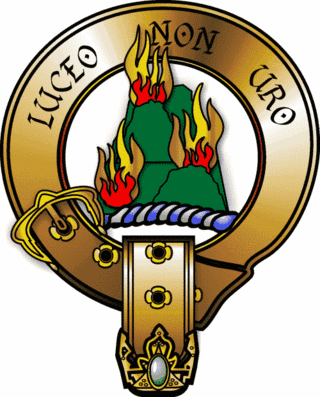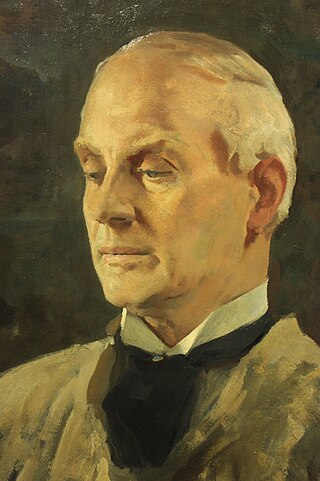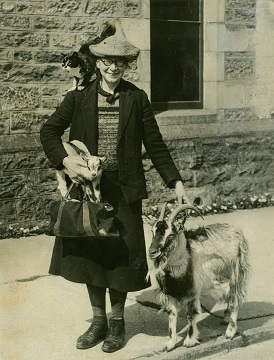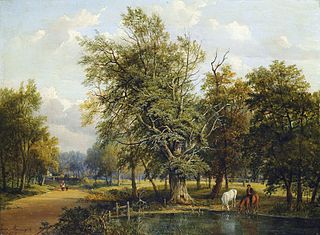
Ross and Cromarty, is an area in the Highlands and Islands of Scotland. In modern usage, it is a registration county and a lieutenancy area. Between 1889 and 1975 it was a county.
The Scottish Colourists were a group of four painters, three from Edinburgh, whose Post-Impressionist work, though not universally recognised initially, came to have a formative influence on contemporary Scottish art and culture. The four artists, Francis Cadell, John Duncan Fergusson, Leslie Hunter and Samuel Peploe, were prolific painters spanning the turn of the twentieth century until the beginnings of World War II. While now banded as one group with a collective achievement and a common sense of British identity, it is a misnomer to believe their artwork or their painterly careers were heterogeneous.

Clan Mackenzie is a Scottish clan, traditionally associated with Kintail and lands in Ross-shire in the Scottish Highlands. Traditional genealogies trace the ancestors of the Mackenzie chiefs to the 12th century. However, the earliest Mackenzie chief recorded by contemporary evidence is Alexander Mackenzie of Kintail who died some time after 1471. Traditionally, during the Wars of Scottish Independence, the Mackenzies supported Robert the Bruce, but feuded with the Earls of Ross in the latter part of the 14th century. During the 15th and 16th-centuries the Mackenzies feuded with the neighboring clans of Munro and MacDonald. In the 17th century the Mackenzie chief was made Earl of Seaforth in the peerage of Scotland. During the Scottish Civil War of the 17th century the Mackenzies largely supported the Royalists. During the Jacobite rising of 1715 the chief and clan of Mackenzie supported the Jacobite cause. However, during the Jacobite rising of 1745 the clan was divided with the chief, Kenneth Mackenzie, Lord Fortrose, supporting the British-Hanoverian Government and his relative, George Mackenzie, 3rd Earl of Cromartie, supporting the Jacobites.

Dame Elizabeth Violet Blackadder, Mrs Houston, was a Scottish painter and printmaker. She was the first woman to be elected to both the Royal Scottish Academy and the Royal Academy of Arts.

Beauly is a village in Scotland's Highland area, on the River Beauly, 12 miles (19 km) west of Inverness by the Far North railway line. The town is historically within Kilmorack Parish of the County of Inverness.

Horatio McCulloch, sometimes written MacCulloch or M'Culloch, was a Scottish landscape painter.

Sir David Young Cameron was a Scottish painter and, with greater success, etcher, mostly of townscapes and landscapes in both cases. He was a leading figure in the final decades of the Etching Revival.

Kilmorack is a small hamlet in Inverness-shire, in the Highlands of Scotland and now in the Highland Council area. It is situated on the north bank of the River Beauly, 3 miles west of Beauly and 15 miles west of the city of Inverness. The river is part of the Affric-Beauly hydro-electric power scheme, with a dam and power station at Kilmorack. The old parish church (1786) was adapted in 1997 to show contemporary Scottish art in Kilmorack Gallery.
Eugenia Vronskaya is a Russian figurative painter.

Katharine Cameron RWS RE was a Scottish artist, watercolourist, and printmaker, best known for her paintings and etchings of flowers. She was associated with the group of artists known as the Glasgow Girls.

Robert Hamilton Macintyre TD RIBA ARIAS was a Scottish architect with a particular interest in church architecture and in the work of Charles Rennie Mackintosh. He was a champion of causes to improve the arts facilities and architecture of Inverness, the Highland capital.

Scottish art in the nineteenth century is the body of visual art made in Scotland, by Scots, or about Scottish subjects. This period saw the increasing professionalisation and organisation of art in Scotland. Major institutions founded in this period included the Institution for the Encouragement of the Fine Arts in Scotland, the Royal Scottish Academy of Art, the National Gallery of Scotland, the Scottish National Portrait Gallery and the Glasgow Institute. Art education in Edinburgh focused on the Trustees Drawing Academy of Edinburgh. Glasgow School of Art was founded in 1845 and Grays School of Art in Aberdeen in 1885.

Andrew Paterson was an internationally renowned and multi-award-winning Scottish portrait photographer whose services were sought over several decades by many leading political and commercial figures.
Will Maclean MBE is a Scottish artist and professor of art.

Inverness Museum and Art Gallery is a museum and gallery on Castle Wynd in Inverness in the Highlands of Scotland. There is no entry charge to the museum and art gallery but donations are welcome. The collection and facilities are managed by High Life Highland on behalf of Highland Council.

David Eustace is an international artist and director, primarily known for his portrait photography. He has worked on campaigns for clients worldwide and travelled extensively. His photographic works are included in several collection, both private and public including the Scottish National Portrait Gallery, Glasgow Museum of Modern Art., Deutsche Bank Collection and The City of Edinburgh Art Collection.

Kilmorack Gallery reuses a converted church building for its exhibitions, in a rural location near Beauly in Inverness-shire, Scotland. It was established as a commercial gallery in 1997 after the building was purchased by art dealer Tony Davidson, believing that inspirational art could sit in an inspirational building just as well as in a white cube. By putting on consistently ambitious solo and mixed shows of some of the country's finest artists and sculptors, Kilmorack Gallery has established itself as one of Scotland's leading contemporary art galleries. The success of non-urban, destination galleries like Kilmorack 'has made "remote" more than ever a relative term', wrote art critic Duncan Macmillan of the Scotsman. Davidson and art critic Jan Patience featured on The Janice Forsyth Show in May 2013, speaking about the gallery and the works on exhibition.

Isabel Frances Grant MBE (1887–1983) was a Scottish ethnographer, historian, collector and pioneering founder of the Highland Folk Museum.

Jane Nasmyth was a Scottish landscape painter of the Nasmyth School in Edinburgh. She was the daughter and student of the portrait and landscape painter Alexander Nasmyth.
Colin Brown is a British painter and collage artist based in Stonehaven, Scotland.
















